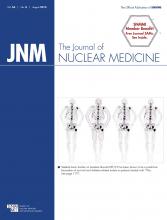There is a growing pharmaceutical and biomedical interest in the opportunity to boost or inhibit the activity of the immune system at the site of disease. The experimental demonstration that most human tumors contain at least 1 mutation per megabase (i.e., more than 1,000 mutations in the whole genome (1)) suggests that various mutated peptides may be presented on major histocompatibility complex class I molecules (human leukocyte antigen class I in humans) and be recognized by specific T cells, thus serving as potential tumor rejection antigens. The existence of such peptides provides a strong rationale for the design and implementation of immunotherapeutic strategies against various types of malignancies. More broadly, T cell–based recognition of peptides presented on major histocompatibility complex class I and class II molecules is crucially important for a broad variety of disease conditions, including chronic inflammatory processes, organ rejection, autoimmunity, and allergy.
See page 1258
Antibodies that target the inhibitory proteins CTLA-4 and PD-1 act as potent stimulators of the immune system and have gained marketing authorization (or are in advanced clinical trials) for the treatment of various types of cancer, including metastatic melanoma (2–4). Moreover, antibody–cytokine fusion proteins, capable of selective localization in cancer or at sites of chronic inflammation, are currently being investigated in clinical trials, with the potential to selectively boost or inhibit immunity at the site of disease (5–9). These and other immunomodulatory strategies crucially affect the activity of T cells. In addition, the genetic engineering of artificial receptors on T cells is opening new avenues for the treatment of hematologic malignancies and, potentially, other tumor types (10).
The opportunity to study T cell activities in humans is often limited and, in most cases, restricted to the ex vivo analysis of lymphocytes in biopsies (e.g., staining of lymphocyte infiltrates) or in blood (e.g., by the tetramer-assisted investigation of T cell specificities by fluorescence-activated cell sorter (11,12)). The ability to image T cells in vivo could open novel biomedical opportunities, both for the study of fundamental immune processes in health and in disease and for the monitoring of responses to pharmacologic intervention.
In this issue of The Journal of Nuclear Medicine, Anna Wu et al. describe the successful imaging of secondary lymphoid organs, rich in T cells, using radiolabeled monoclonal antibodies, directed against the CD4 or CD8 T cell antigens (13). Specifically, the authors used antibodies in diabody format, which is cleared more rapidly than the corresponding parental IgG format and is thus more suitable for in vivo imaging applications (14,15). The radiolabeled antibody fragments, which were specific to mouse CD4 and CD8 antigens, nicely imaged the lymph nodes and spleen in immunocompetent mice, with excellent selectivity (as confirmed by the quantitative assessment of percentage injected dose per gram of tissues in various organs and body structures). Several control experiments, including the administration of radiolabeled antibodies after a suitable lymphocyte depletion step with unlabeled antibodies, were performed to confirm the specificity of the imaging procedure.
The article is important for several reasons. First, the authors nicely show that the CD4- and CD8-specific diabodies are not trapped in blood by circulating lymphocytes, which are present at a lower density, compared with solid structures in secondary lymphoid organs. Second, the experiments suggest that it may be possible to gain information about T cell density in certain tissues (e.g., in tumors) from the corresponding signals in nuclear medicine investigations.
What can we expect from future development in the field? On one hand, it will be important to experimentally validate whether T cell infiltrates in tumors can be quantitatively assessed in rodent models of cancer and in patients, using suitable diabody-based imaging agents. Furthermore, similar imaging strategies could potentially be used for the in vivo monitoring of engineered T cell specificities (e.g., those clinically used in chimeric antibody receptor technology (10)). More broadly, the availability of surface markers for defined subsets of T cells (or other leukocytes) may allow a finer quantification of cellular infiltrates in organs and diseased tissue. Molecular imaging techniques may therefore become extremely important for the industrial and clinical development of immunomodulatory agents.
What will be the main future challenges? First, distinctive surface markers for many important T cell subtypes (e.g., regulatory T cells) are not yet available. Second, signal to noise in imaging procedures may decrease, if antibodies that target rare lymphocyte populations are used. On the other hand, the extensive knowledge available for the expression patterns of cluster of differentiation antigens on leukocytes in health and disease would deserve imaging investigations, with affinity reagents similar to the ones described in the current study (13). In this respect, CD4 and CD8 may represent only the beginning of a more extensive series of nuclear medicine investigations. Finding a balance between the regulatory need to comply with good manufacture practice guidelines and the need to clinically investigate various types of antibody molecules will also represent a formidable challenge in translational medicine.
Footnotes
Published online May 21, 2015.
- © 2015 by the Society of Nuclear Medicine and Molecular Imaging, Inc.
REFERENCES
- Received for publication May 8, 2015.
- Accepted for publication May 11, 2015.







